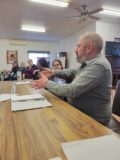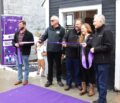Headline News
Outdoor learning COVID-19 renaissance
September 21, 2020
Sept. 16, 2020
By Mike Riley
Local Journalism Initiative Reporter
Schools in Ontario have been closed since March 13, due to the COVID-19 induced state of emergency. With Ontario students returning to school on Sept. 2, the Hastings Prince Edward District School Board and the Hastings Prince Edward Public Health have worked to ensure that all 40 schools in their region are complying with provincial directives to ensure staff and students remain safe during their return. Some schools like Hermon Public School in Carlow Mayo Township, and Coe Hill Public School, which serves Wollaston, Limerick and Tudor and Cashel townships, have gone a step further. Following the advice of the Ford government, education experts and HPEPH, they’ve incorporated outdoor classrooms into their learning schedules, thereby ensuring an even safer learning experience for their students.
Despite the fact that the resurgence in outdoor learning’s popularity has been due to COVID-19, teachers have recognized its value for thousands of years, going back to ancient Greece. In Ontario, outdoor education first took hold back in the 1800s when Ontario’s first superintendent of education, Dr. Egerton Ryerson, saw that adding outdoor education to the public-school curriculum would ensure higher attendance from students in agricultural communities, with this focus on outdoor learning taking on added resonance in their daily lives. Pre-COVID-19, Indigenous communities recognized the merits of outdoor learning and there were a small number of schools offering outdoor classes like the Royal Roads Public School in Ingersoll, the Tiny Forest Academy in Tiny, and Stirling Public School in Stirling. With the pandemic, the number of schools offering outdoor classes is starting to rise.
Ron Keen is the CEO of Forests Ontario, an organization dedicated to making Ontario forests greener and educating kids through a connection with nature.
“We’ve been promoting outdoor education for quite a while, trying to get youth outside and engaged with the outdoors. It’s very positive in my mind. It’s a safer environment too, considering COVID-19 and everything associated with that,” he says.
The benefits of outdoor learning, according to Keen, include improved mood, more appreciation for the outdoors, better retention of subject material, improved learning for tactile and experiential learners, improved social skills and lower rates of bullying, better understanding of ecological concepts, and putting physical activity into all subject areas. Forests Ontario also put together a guide for outdoor learning in partnership with Focus on Forests and the TD Friends of the Environment Foundation called Building Outdoor Classrooms, which is available online at forestsontario.ca for educators to consult for their own outdoor classrooms.
Ingrid Anderson is with the communications branch of the Ontario Ministry of Education and agrees that outdoor learning can enhance the delivery of existing curriculum, and educators have been given the leeway to make those decisions to move their lessons outside. She says that every year all Ontario school boards get outdoor education funding that totalled $17.7 million in 2020/2021.
“During these exceptional times when physical distancing is important, we are encouraging boards to be creative with the use of outdoor spaces that are available to them within reasonable walking distance,” she says.
Kerry Donnell is the communications and public relations manager with the HPEDSB. She says that with some of their schools being in rural and suburban areas, they have the space for outdoor learning.
“It looks different at each school depending on the size and shape of the yard for example. Innovative approaches, like the one at Hermon Public School, are encouraged as much as possible. School administrators and teachers have the flexibility to use inside and outside spaces for learning, keeping in mind safety and the required physical distancing,” she says.
Taras Humen is the vice principal of Hermon Public School in Carlow Mayo Township. His school and others within the HPEDSB have met all the safety requirements for reopening during COVID-19, and he says that the board has been a great source of guidance for making all of that happen. His staff have been creative, adapted and looked for further opportunities to enhance staff and student safety. The result was moving their classes outside.
“We just thought of what we would need to teach outdoors and we came up with a simple but powerful idea. If you look at outdoor learning and forest schools online, there’s a healthy movement to embrace learning in a natural environment. So, it’s not unheard of but we’ve taken the lead,” he says.
They now have an outdoor classroom for each of their five homerooms, with a whiteboard, a teaching stone for kids to study books or objects and 15 tree stumps in each classroom for students to sit on.
“On a nice day, the school could be empty apart from using the washrooms. We could conduct an entire day’s worth of learning outdoors without difficulty, when the weather cooperates,” he says.
On a rainy day, they move things indoors but he could see having outdoor classes go on as time goes by, even in inclement weather, and perhaps even in the winter. As the popular Scandinavian expression goes; “there is no bad weather, just bad clothing.”
Humen says that every class is colour coordinated which helps the younger kids, but the older kids have all painted their stumps to reflect their unique personalities.
“The older kids are really running with this. We have a class of Grade 5/6 students that built on to what we had begun. They started building short walls around the rooms to keep out the wind, using materials from around here. So, the kids really like [the new outdoor classrooms],” he says.
What was really overwhelming, according to Humen, was the support the school got from the Hermon community. He says he got 12 to 15 phone calls from parents asking ‘what can I do?’ and ‘What do you need?’ before the school reopened. Ultimately the outdoors classrooms were built by four key families in the area, at no cost to the school. He mentions Bill Douglas, who used his tractor to auger the holes for the wooden posts, Brian Trolley, who works for Freymond Lumber, who was able to provide free posts, Eric Dillabough from G. Dillabough Forest Products who was able to get 75 tree stumps for the students to sit on, and Jeff, Sarah and Logan Dillabough, who came through with all the big stones that grace each classroom.
“Our families made this happen. This is the community. The roots of this place go deep and people’s attachment to it is profound,” he says.
Humen says that although they’ve got the basics of good outdoor classrooms going already, they would like to add to it going forward.
“We’re thinking of planting trees around the classrooms and creating these little groves. When the trees grow up, you’ll get some nice wind protection and shade. And it’ll be part of the students’ learning. We’re a pretty modest bunch, but at times like this it’s good to let people know that this can work,” he says.
Humen mentions Rob Lake, the principal at Coe Hill Public l, which serves the townships of Wollaston, Limerick and Tudor and Cashel.
“He’s the best principal, he’s amazing. They’ve always done outdoor learning at that school so I wouldn’t be surprised if they’ve taken the tiger by the tail.”
Indeed, Coe Hill Public School has done just that. For the past six years, their early childhood education teachers have had an early learning program with a dedicated outdoor space for their kindergarten students. Lake explains that several years ago, through a Best Start grant, money was invested in creating this outdoor space.
“So, for the last whole block of the day, rain or shine, they’re outside. Cold, let’s dress prepared. We’ve got an enclosed space so it’s safe, individual stumps for seating, a whiteboard, organized and disorganized materials for creative learning and kitchen centres. We’re in the process this fall of getting some shade put up for them. But we really see it as an opportunity, not just a requirement,” he says.
Jennifer White, a designated early childhood educator, says that she and Mary Connolly, a kindergarten teacher, were texting each other before the reopening about how amazing it was that the outdoor space was in place .
“We can hit the ground running with outdoor learning. Now is the time that we have to do this. We wanted to do it before, but now it’s a necessity,” she says.
Lake says that they’re hoping to get more outdoor spaces organized and built soon.
“I know that Taras [Humen] has the five classrooms out there [at Hermon Public School], but we wanted to start small and slowly get bigger. That was deliberate to wait and see what the protocols would be. I have a background in landscape design, so we’re hoping to get these outdoor spaces sectioned off for different purposes. We used to be able to travel to other places more easily, but not so much now. So, let’s try to build some things here. We’ve got some ideas that we’re working on,” he says.
Besides the kindergarten outdoor learning space, another area that has been in place for several years is a butterfly garden. Connolly would bring in butterfly larvae each Spring and the students would be able to watch the whole process as they metamorphosed into butterflies, and Lake said it was a great learning experience for the kids.
Lake gives special mention to all his staff, who have gone above and beyond to prepare for the school’s reopening and ensuring that the school meets all the health and safety requirements dictated by the province and public health. They have also been crucial to making the outdoor learning happen as well as it has and as well as it will going into the future.
“We have had a great start up. The kids are so happy to be back. They just want to have trusting relationships, people that care about them and positive experiences. They have come back to school and they’re ready to go,” he says.
Lake says that teaching kids outside is a great idea and they know that it works.
“We know the possibilities but how do we make it happen better? So hopefully, COVID-19 is now the opportunity to say, now’s the time for outdoor learning.”


















